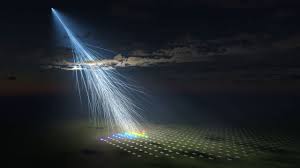Amaterasu : Cosmic Ray

Scientists recently detected the most powerful cosmic ray seen in more than three decades, which has been named ‘Amaterasu’.
- Amaterasu is one of the highest-energy cosmic rays ever detected.
- It has been named Amaterasu after the Japanese sun goddess.
- It has an energy exceeding 240 exa-electron volts (EeV). That is millions of times more than particles produced in the Large Hadron Collider, the most powerful accelerator ever built, and equivalent to the energy of a golf ball travelling at 95 mph.
- It comes only second to the Oh-My-God particle, another ultra-high-energy cosmic ray that came in at 320 EeV, detected in 1991.
- Amaterasu appears to have emerged from the Local Void, an empty area of space bordering the Milky Way galaxy.
- Cosmic Rays are echoes of violent celestial events that have stripped matter of its subatomic structures and hurled it through the universe at nearly the speed of light.
- Essentially, cosmic rays are charged particles with a wide range of energies consisting of positive protons, negative electrons, or entire atomic nuclei that travel through space and rain down onto Earth nearly constantly.
- They hit Earth’s upper atmosphere and blast apart the nucleus of oxygen and nitrogen gas, generating many secondary particles.
- These travel a short distance in the atmosphere and repeat the process, building a shower of billions of secondary particles that scatter to the surface.




